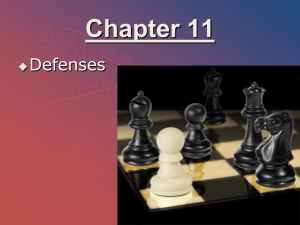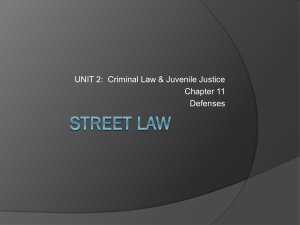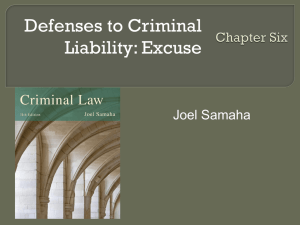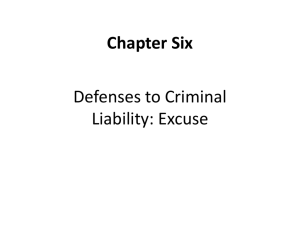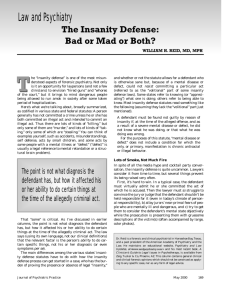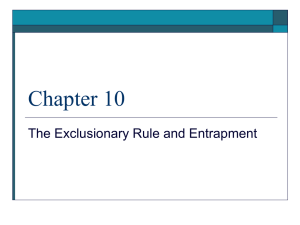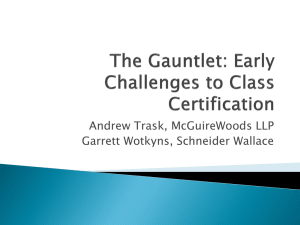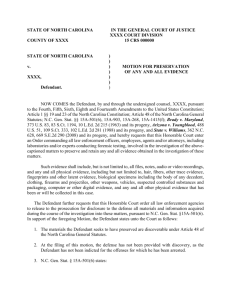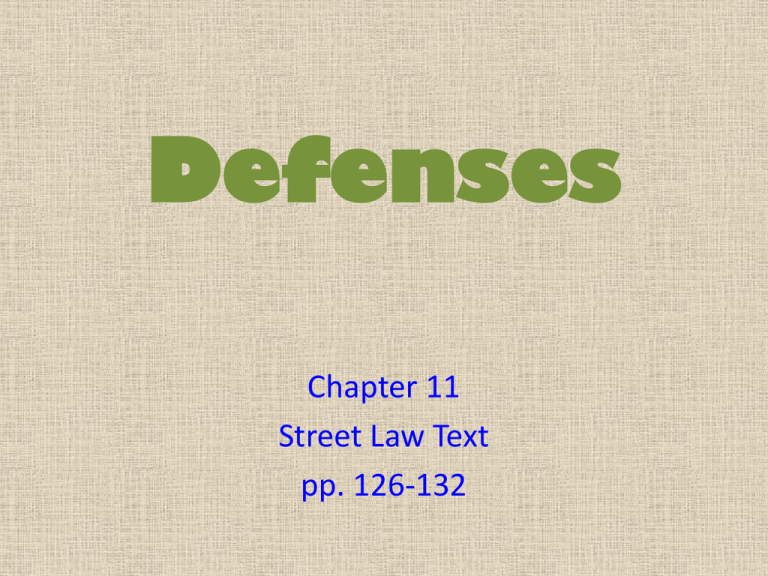
Defenses
Chapter 11
Street Law Text
pp. 126-132
• Beyond a Reasonable Doubt… There must be a
conviction by the state [prosecutor] proving that
a person is guilty of a crime. You are “innocent
until PROVEN guilty”. Of course we also know
you can PLEAD guilty or no-contest.
• One of the best defenses is that No Crime Has
Been Committed!
– No Criminal Act was Committed
• Carrying a gun, but had a permit/ Not rape because of
consent
– No Criminal Intent was Involved
• Accidentally took another persons coat, luggage, etc. Not
larceny if it was unintentional, honest, and reasonable
mistake.
Defendant Did Not Commit the Crime
Most times there is no doubt that a crime was
committed, but rather, who did it?
Alibi-Evidence that the defendant was somewhere
else at the time the crime was committed.
DNA Evidence- Biological evidence linking a
specific person to a crime scene, blood, hair, body
fluids, etc
Alibi’s and the use of DNA evidence can help
prove a defendant was not at the crime scene,
although usually must be corroborated by others
DNA evidence can be used by the Prosecution or
Defense, and today there are convicted criminals
that are having their sentences overturned
because of DNA evidence
Defendant Committed the Act, but it was
Excusable or Justifiable
Self Defense- The law recognizes the right of a person
to defend themselves using “reasonable” force
themselves
Defense of Others- The law also protects an individual
that comes to the aid of another that is being, or
could be, attacked
With both Self Defense and Defense of others a
person can not use deadly force unless they are
threatened with the same, and they must stop a
“defense” when the threat is stopped
Defense of Property- A person is allowed to protect
their property using nondeadly force, unless their
state has a Castle Doctrine [Stand Your Ground/Make
My Day Laws]
Problem 11.1
a. Ms. Urbanski kept a pistol in her home as protection against intruders. One
evening, she heard a noise in the den and went to investigate. Upon entering the
room, she saw a man stealing her television. The burglar, seeing the gun, ran for
the window, but Ms. Urbanski fired and killed him before he could escape. In a
trial for manslaughter, Ms. Urbanski pleaded self-defense. Would you find her
guilty? Why or why not?
b. Mr. Peters has a legal handgun to protect his home against intruders and against
the increasing crime in his neighborhood. One night Takeshi, a 16 year old
Japanese exchange student, walks up Mr. Peter’s driveway looking for a party.
Takeshi thinks Mr. Peters is hosting the party and begins yelling and waving his
arms. Mr. Peters gets scared, retrieves his handgun, and points it at Takeshi while
yelling “Freeze!” Takeshi does not understand English and keeps walking toward
Mr. Peters. Thinking he is an intruder, Mr. Peters shoots and kills Takeshi at the
front steps of his house. Mr. Peters is charges with first-degree murder. Does he
have a defense?
c. Would your answers to a and b above be any different if your state had a “Stand
Your Ground Law” or a “Make My Day Law”?
d. The owner of a jewelry store witnesses a shoplifter stealing an expensive diamond
necklace. Can the owner use force to prevent the crime? If so, how much?
Defendant Committed the Act but Is Not
Criminally Responsible
Sometimes Crimes are committed but the defendant is deemed to lack
criminal responsibility. Infancy, Intoxication, insanity, entrapment,
duress, and necessity make up these type of situations.
Infancy- Children under a specified age are not responsible for their
actions. Traditionally Children under the age of 7 are unable to commit
criminal intent. Most states allow prosecutors to decide if a child will
be prosecuted as an adult depending on the seriousness of the crime.
Intoxication- At the time of a crime the defendant was under the
influence of drugs or alcohol, and they did not know what they were
doing.
Intoxication does NOT, in almost all cases, provide a defense for someone that
chose to BECOME intoxicated
Intoxication may be a factor in lessening the charge if it’s a Bar Fight, and the
defendant was so drunk that they didn’t realize what they were doing could cause
the death of another person… Reduction from possibly 2nd degree murder to
manslaughter.
Insanity
The Insanity defense- Because of mental disease or defect, the defendant should
not be held responsible for the crime committed.
The Insanity defense only applies in most states if the defendant was “insane” at
the time of the crime, their mental state after has no bearing on the crime
committed, although it may delay or draw out court proceedings
Most states determine the mental state of the defendant in three areas
The defendant is competent to stand trial
The defendant was sane at the time of the criminal act
The defendant is sane after the trial
The Insanity defense is very controversial, many people
believe hardened criminals have used it successfully to
avoid conviction. Four States have even removed the
defense from their courts.
Problem 11.2
a. What is the insanity defense? How does it
work?
b. Should the insanity defense be kept as it
is, changed in some way, or abolished?
Explain.
Andrea Yates, found not guilty
by reason of insanity
[postpartum depression] in
2006, after drowning her 5
children in 2001 [7, 5, 3, 2,
6m]in their bathtub. Currently
confined to a minimum security
mental hospital.
Entrapment
Entrapment- Defendant claims they were induced or persuaded to
commit a crime by law enforcement officer[s]
There is no entrapment when an officer simply provides the
opportunity to commit a crime. It is difficult to prove and cannot be
used in crimes resulting in serious physical injury
Problem 11.3
Can entrapment be claimed as a valid defense in any of the following cases? Explain.
a. Mary, an undercover police officer masquerading as a prostitute, approaches
Edward and tells him that she’ll have sex with him in exchange for $50. Edward
hands over the money and is arrested.
b. Jan, a drug dealer, offers to sell drugs to Emilio, and undercover officer posing as a
drug addict. Emilio buys the drugs, and Jan is arrested.
c. Rashid, and undercover FBI agent, repeatedly offers Sammy a chance to get in on
an illegal gambling ring, with the promise that he will win big. After refusing
several offers, Sammy, who has no history of gambling and who just lost his job,
finally gives Rashid $200 as a bet. Rashid immediately arrests Sammy.
Duress
Duress- When a person commits a crime as a result of coercion or
a threat of immediate danger to life or personal safety
Under duress a person lacks the ability to exercise free will
Duress can also apply to the threat against a third party if the
defendant does not commit the crime
Example: Someone forcing a person to rob a bank by threatening
that persons life or family
Duress cannot be claimed as a defense for homicide
Necessity
Necessity- When a person is compelled to react to a situation that
is unavoidable in order to protect life.
Example: throwing cargo off a sinking ship [destruction of
property]
Necessity cannot be claimed as a defense for homicide
Problem
11.4
Reread the Case of
the Shipwrecked
Sailors on page 6.
Would any of the
defenses discussed
in this section be
available to the
sailors who
survived and were
prosecuted?
Should they be?
Explain:

